Heart Disease Statistics in the US (2024 Update)
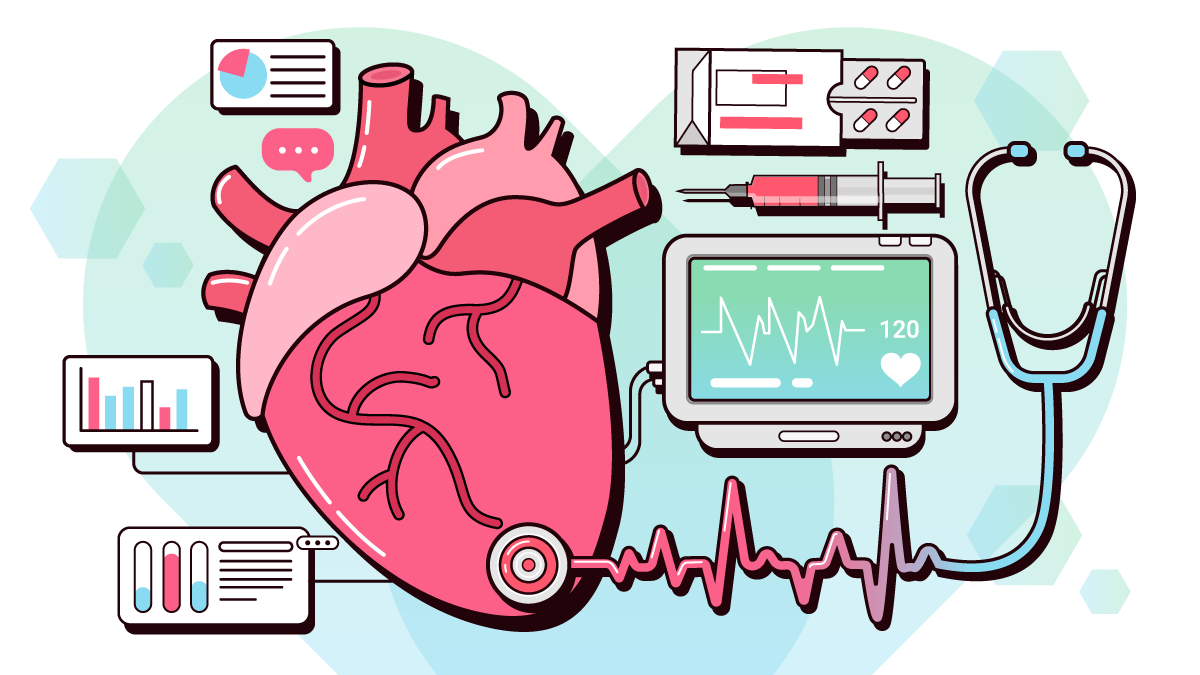
Report Highlights:
- 11.2% of American adults have heart disease [30].
- Heart disease is more common among older people aged 75 years and above at 37.3% [30].
- It affects males more at 12.6%, compared to females at 10.1% [38].
- American Indians have the highest heart disease prevalence rate of 14.6% [30].
- 1 in every 4 Americans dies of heart disease [39].
- The most common type of heart disease is coronary artery disease, affecting 6.7% or 18.2 million American adults [27].
- Coronary artery disease causes 1 in 5 deaths among American adults below 65 years [27].
- Every 40 seconds, one person in the US suffers from a heart attack [38].
- About 14% of the people who had a heart attack will die of it [38].
- Every 36 seconds, one person dies from cardiovascular disease [27].
- Heart failure causes 1 in 8 deaths [38].
- Cardiovascular disease and heart disease cost $378 billion and $228.7 billion respectively in 2017 to 2018. Both of them cost more than cancer, which is at $109 billion [38].
- By 2035, 45.1% of Americans will have cardiovascular disease and expenditure could increase to $1.1 trillion [3].
- 80% of cardiovascular disease cases could have been prevented [8].
The Centers for Disease Control and Prevention defines heart disease as several types of diseases that affect the heart [22].
Of the different types, coronary artery disease or CAD is the most common. This heart condition affects the heart and blood vessels supplying the heart. Not only does this decrease blood flow but also increases heart attack risk.
All types of heart diseases fall under cardiovascular disease since they affect the heart’s blood vessels. However, not all cardiovascular diseases can be called heart disease. One example of this is endocarditis wherein an infection causes inflammation of the heart’s inner linings.
Cardiovascular disease is the leading cause of death. It is also one of the most expensive diseases in the US.
A chronic disease, 80% of the cases could have been prevented by controlling the risk factors [8].
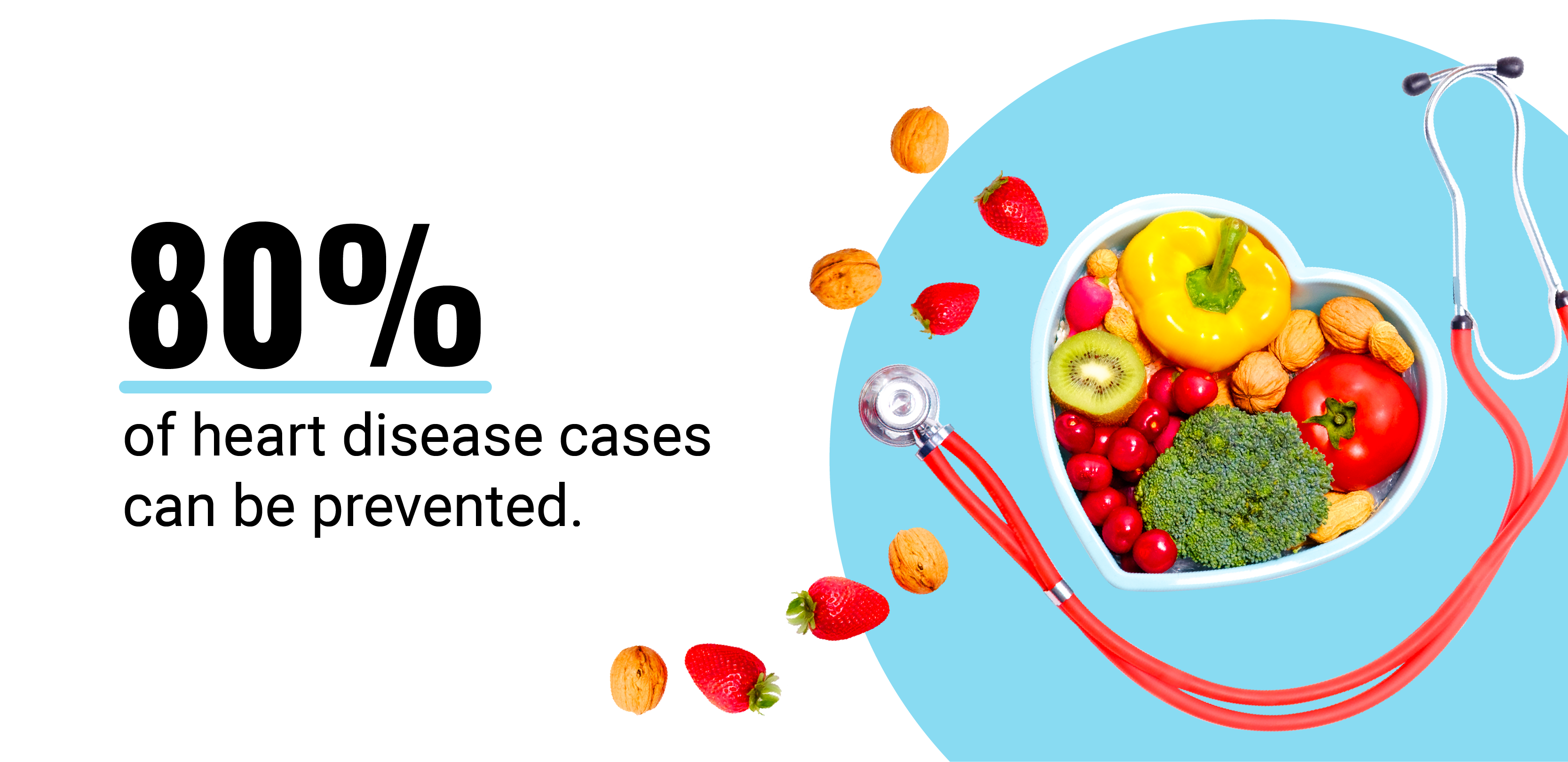
How Many Americans Have Heart Disease?
11.2% of the adults in the US have some type of heart disease, the Centers for Disease Control and Prevention notes [30].
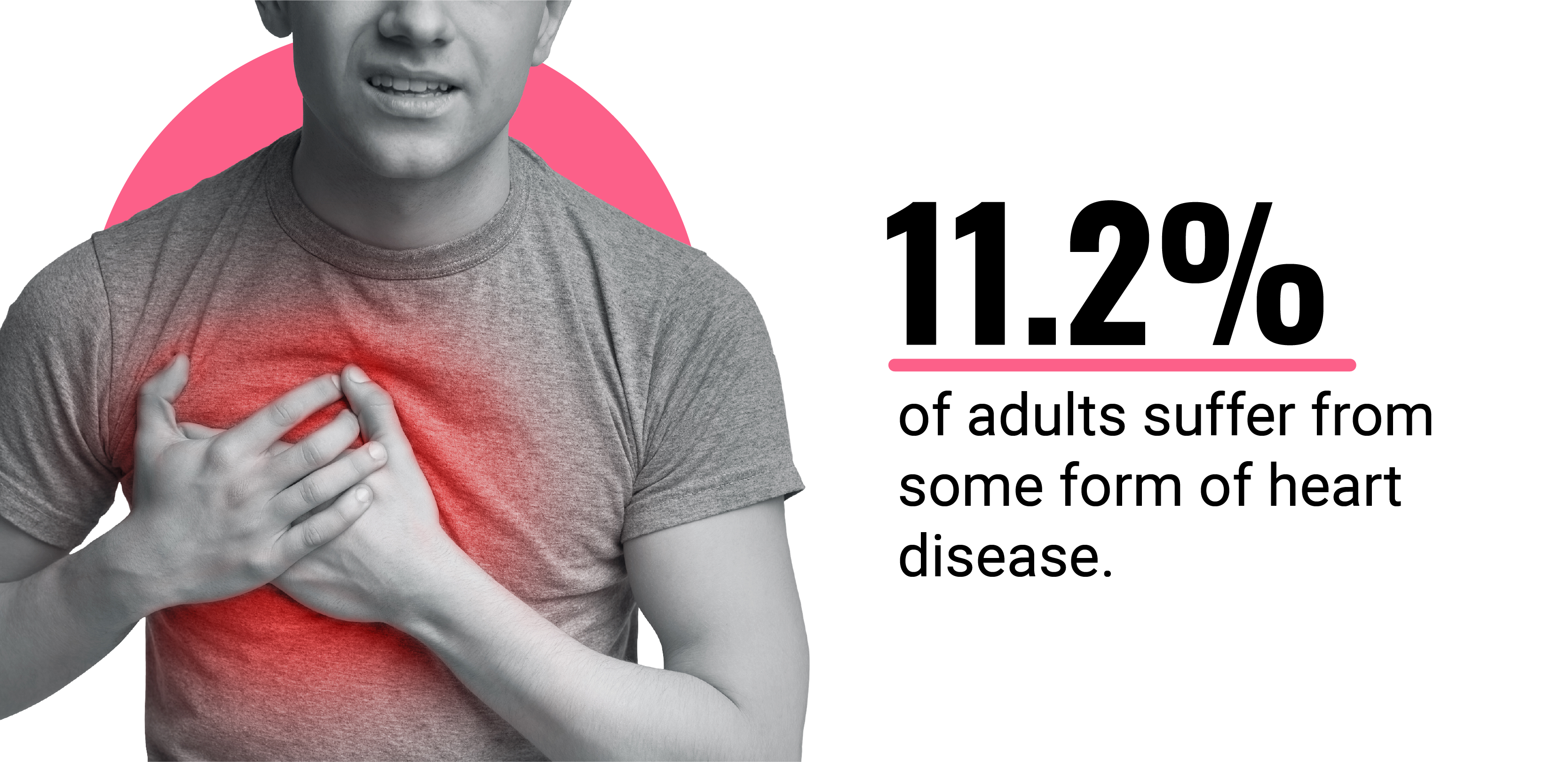
What Causes Heart Disease or Increases Its Risks?
Many risk factors contribute to the development of heart disease. The major risk factors include:
- Hypertension or high blood pressure
- Hypercholesterolemia or high cholesterol level
- Smoking
Other risk factors that can increase risk include:
- Diabetes
- Overweight and obesity
- Unhealthy food choices
- Sedentary lifestyle and physical inactivity
- Excessive alcohol intake
High Blood Pressure
High blood pressure increases heart disease risk by 29% [12].
47% or 116 million Americans have hypertension, but only 24% or about 1 in 4 have their hypertension under control [26].
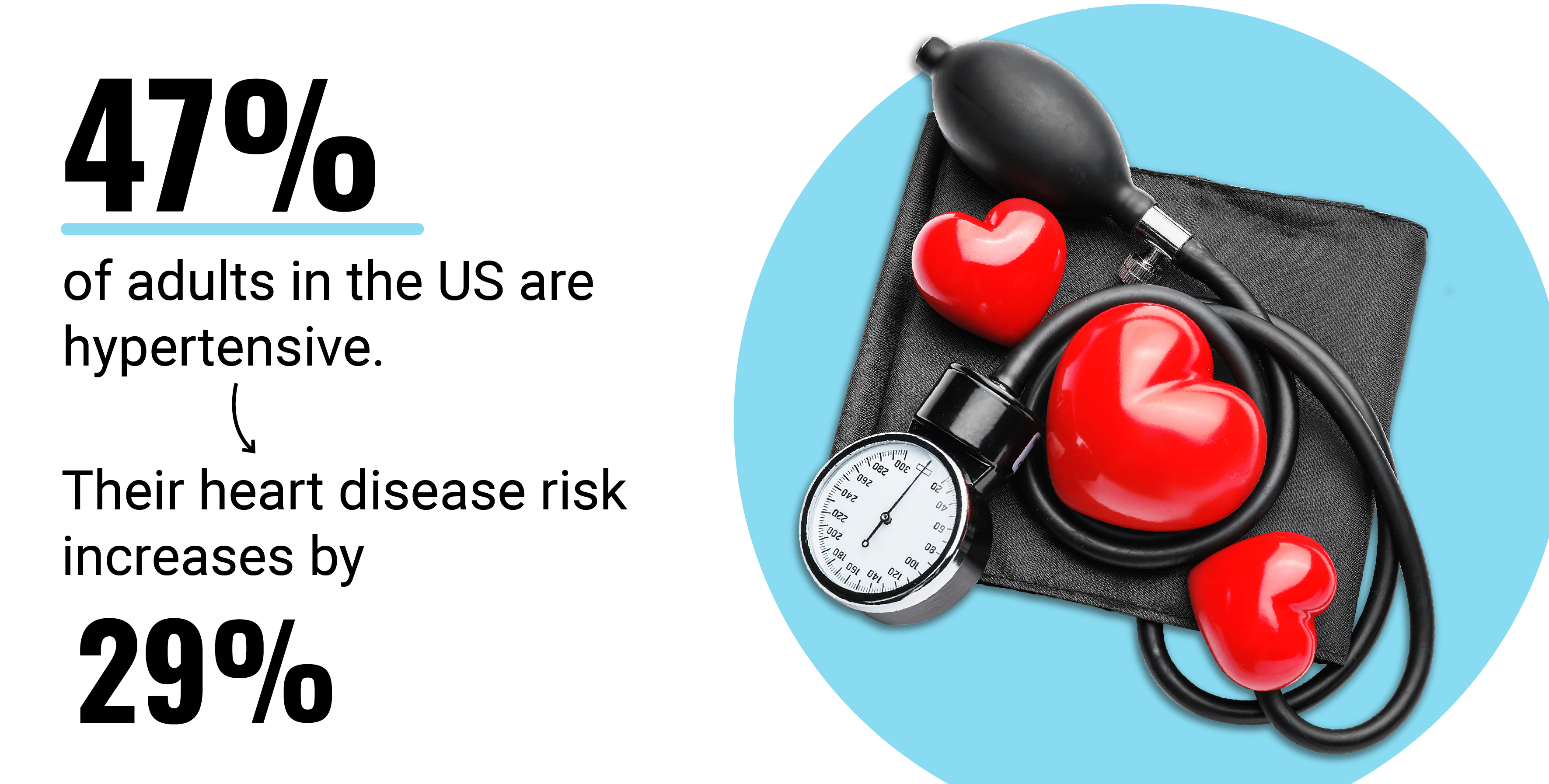
50% to 60% of hypertensive patients may develop heart failure. Women have a three-fold increase in risk, while men have a two-fold increase [35].
High Cholesterol Level
High blood cholesterol levels increase their risk of developing heart disease by 12% [12].
About 38% of adults in the US have high blood cholesterol levels, says the Centers for Disease Control [21].
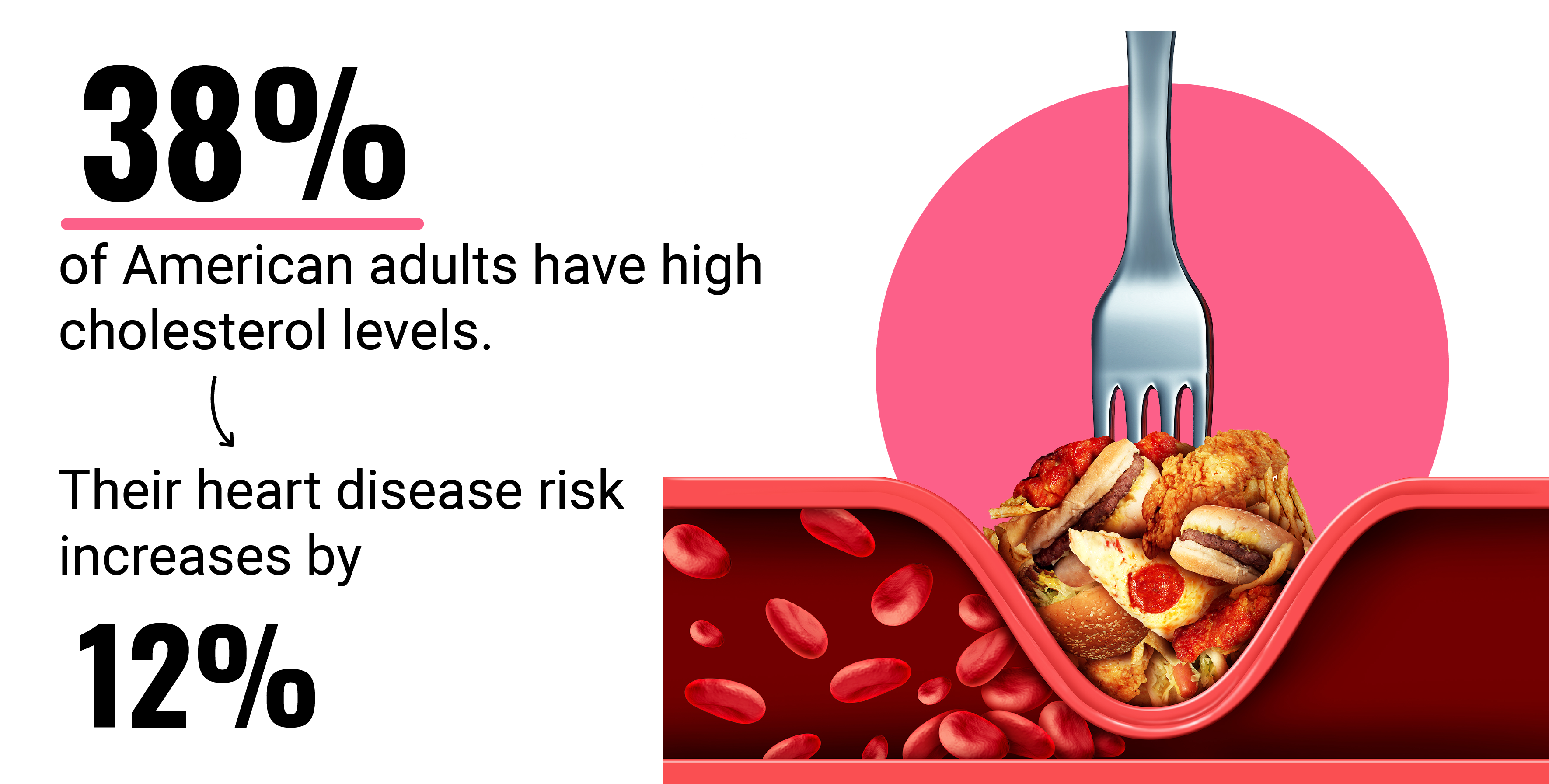
Smoking
A major risk factor, smoking cigarettes increases heart disease risk by 17% [12].
12.5%, 30.8 million, or about 1 in 8 American adults smoke, says the Centers for Disease Control [24].
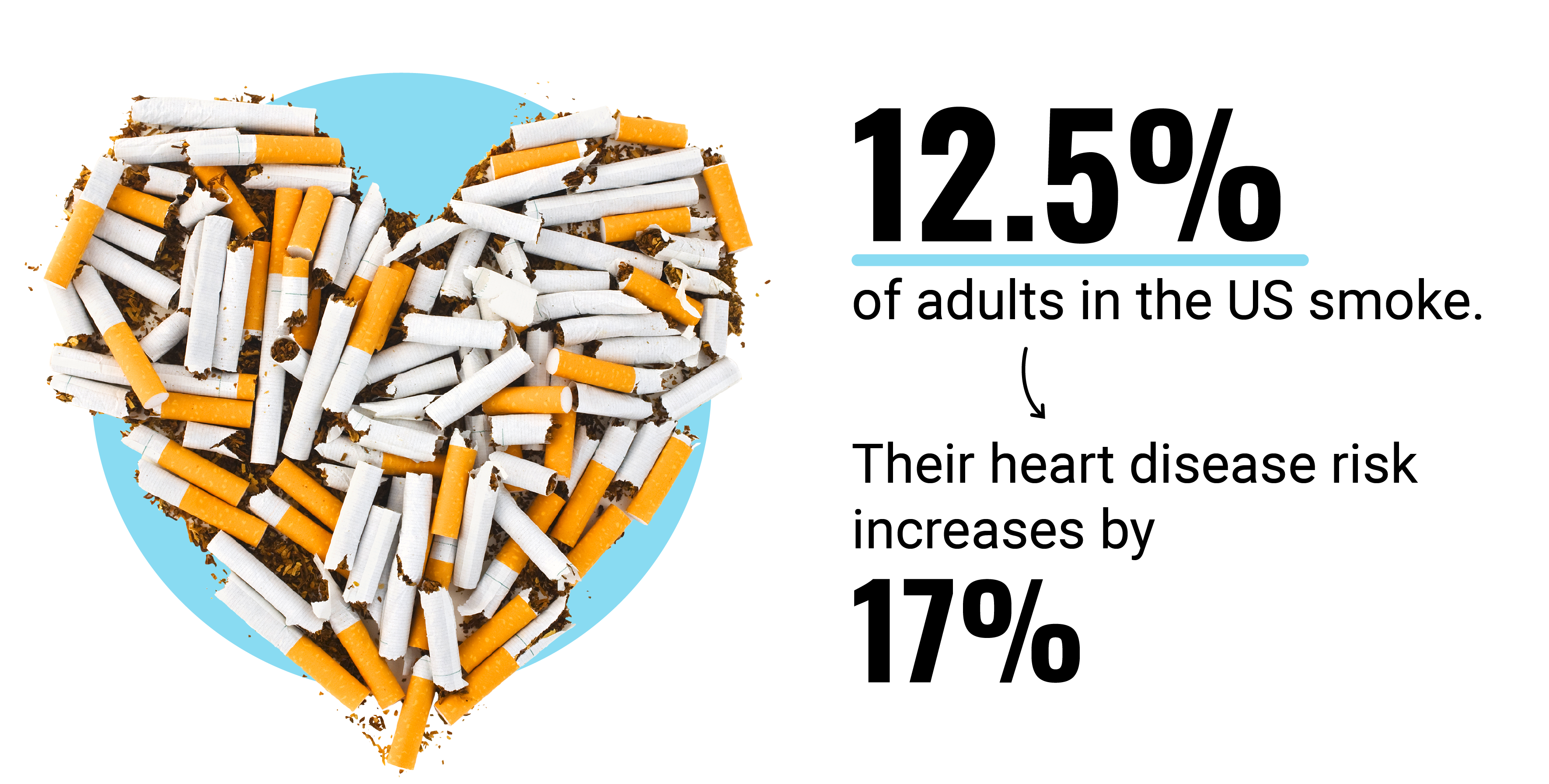
Nonsmokers exposed to secondhand smoke have a 25% to 30% increased risk of developing coronary heart diseases, compared to nonsmokers not exposed to secondhand smoke [15].
According to the US Food and Drug Administration, about 20% of those who died from heart disease are caused by smoking cigarettes [15].
Diabetes
According to Million Hearts, diabetes increases heart disease risk by 9% [12].
37.3 million or 1 in 10 Americans have diabetes. About 1 in 5 of them don’t know they’re diabetic [14].
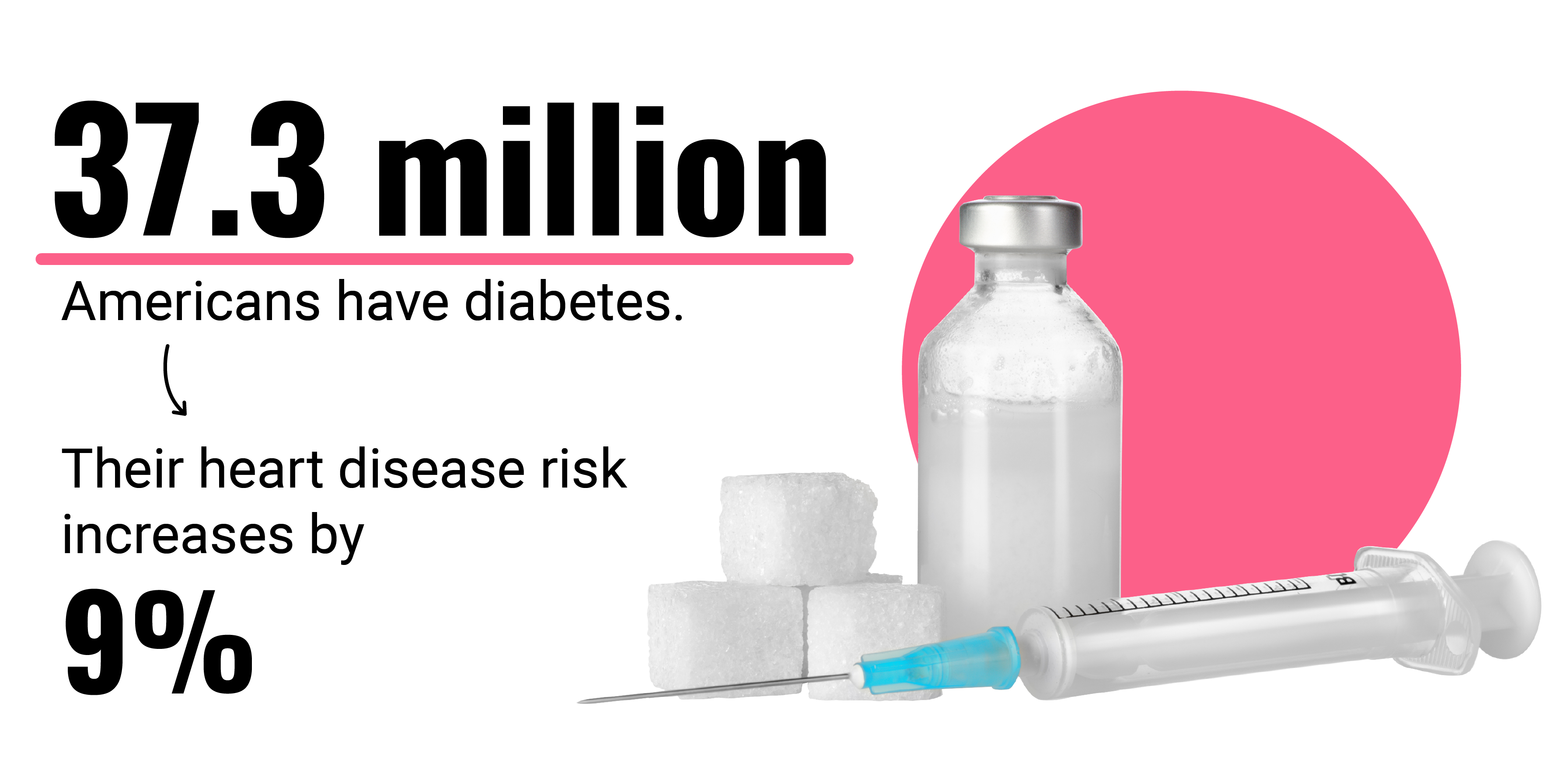
Overweight and Obesity
Obesity and overweight increase heart disease risk by 36% [12].
Health statistics show obesity has a 41.9% prevalence rate in the US [23].
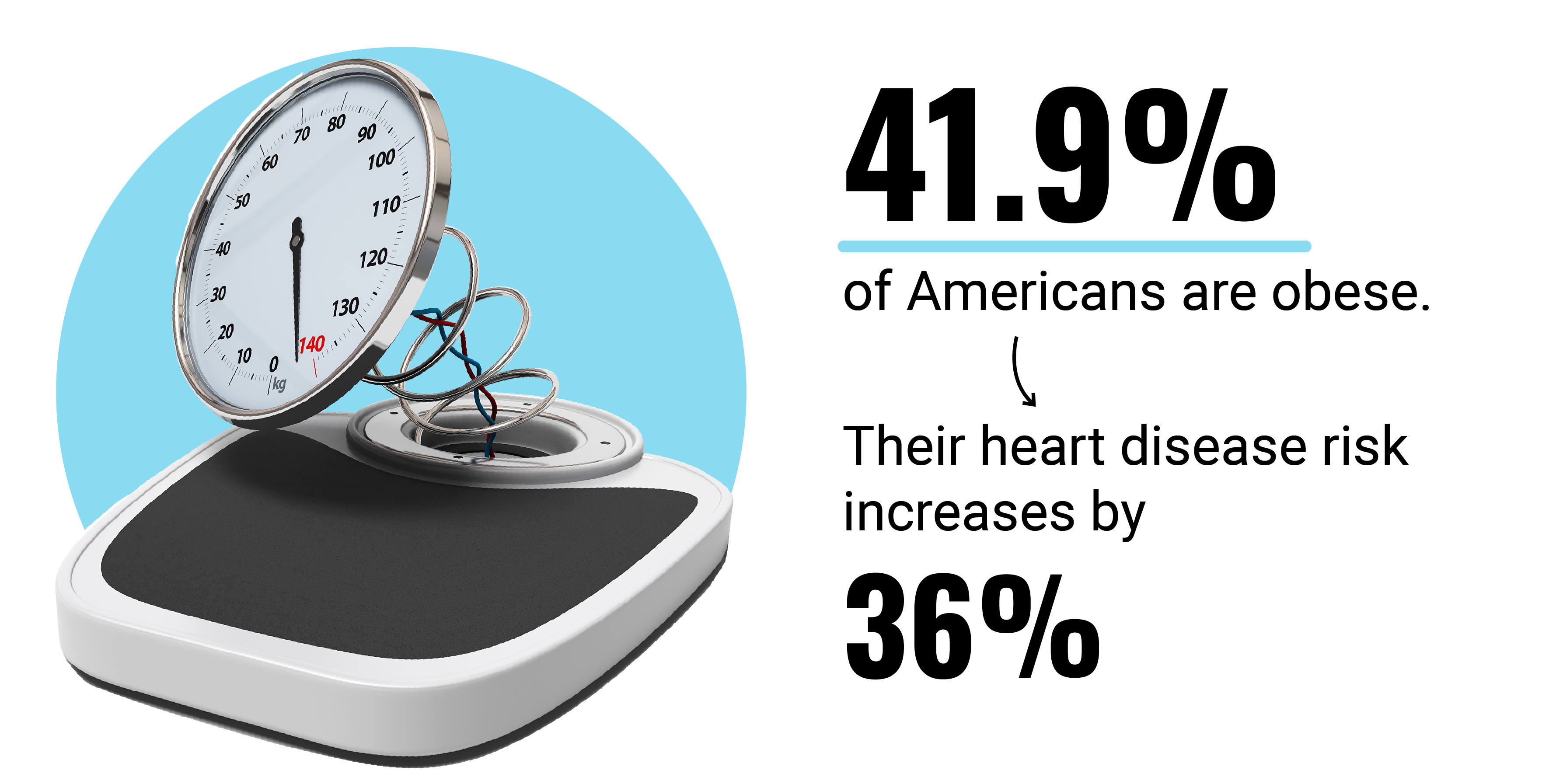
Poor Diet
A poor or unhealthy diet increases heart disease-related death by 13.2% [38]. It has contributed to more than 400,000 deaths caused by heart disease [2].
45.6% of American adults have a poor diet [34].
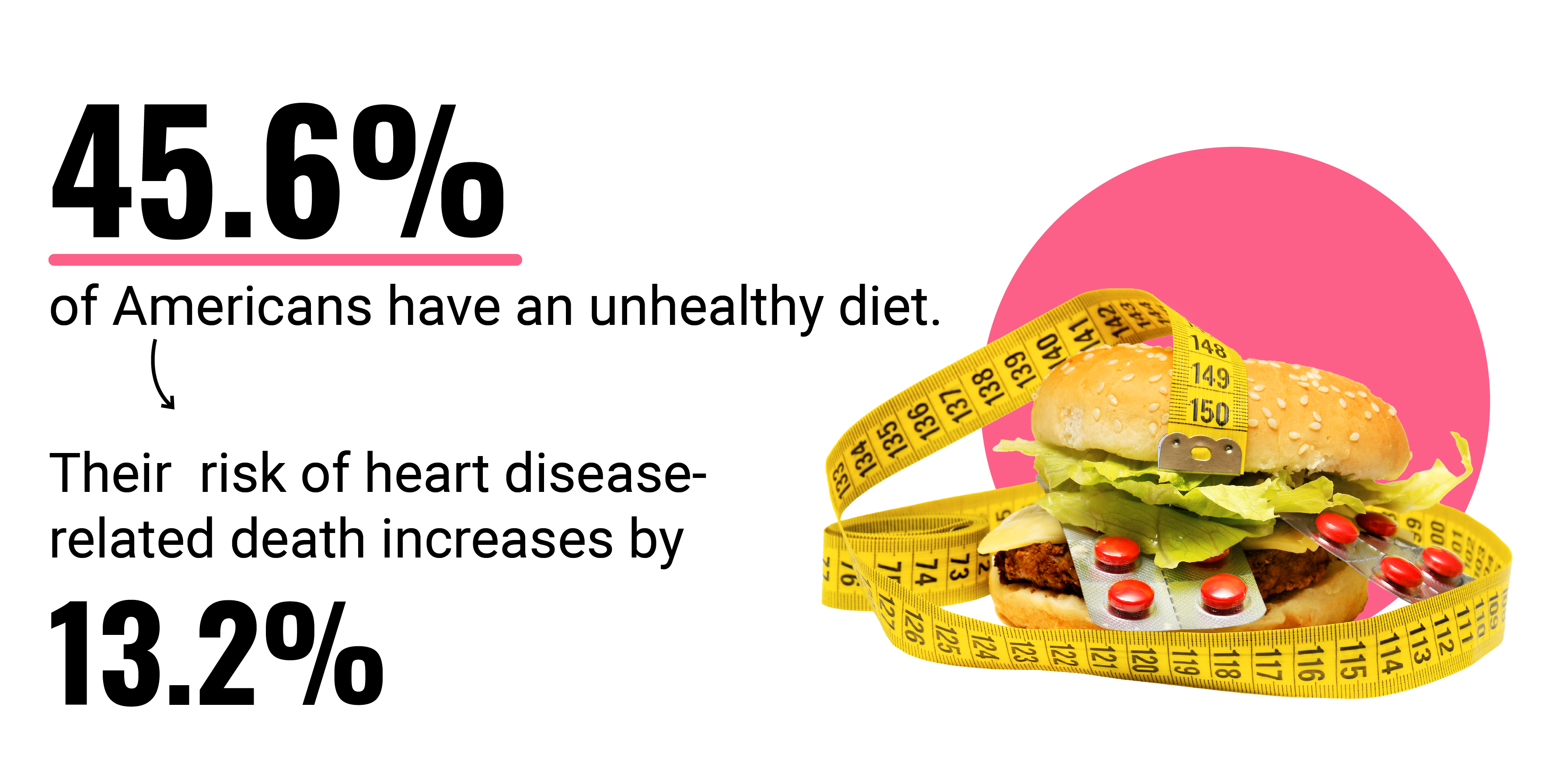
Poor diet also contributes to the development of hypertension, diabetes, hypercholesterolemia, and obesity.
Lack of Physical Activity
People who lack physical activity have a 30% risk of developing heart diseases [12].
According to the Centers for Disease Control and Prevention, about 17.3% to 47.7% of American adults have a sedentary lifestyle [7].

Excessive Alcohol Intake
Excessive alcohol consumption increases heart attack or myocardial infarction (MI) risk by 72% [4].
An estimated 1 in 6 American adults binge-drink [25].
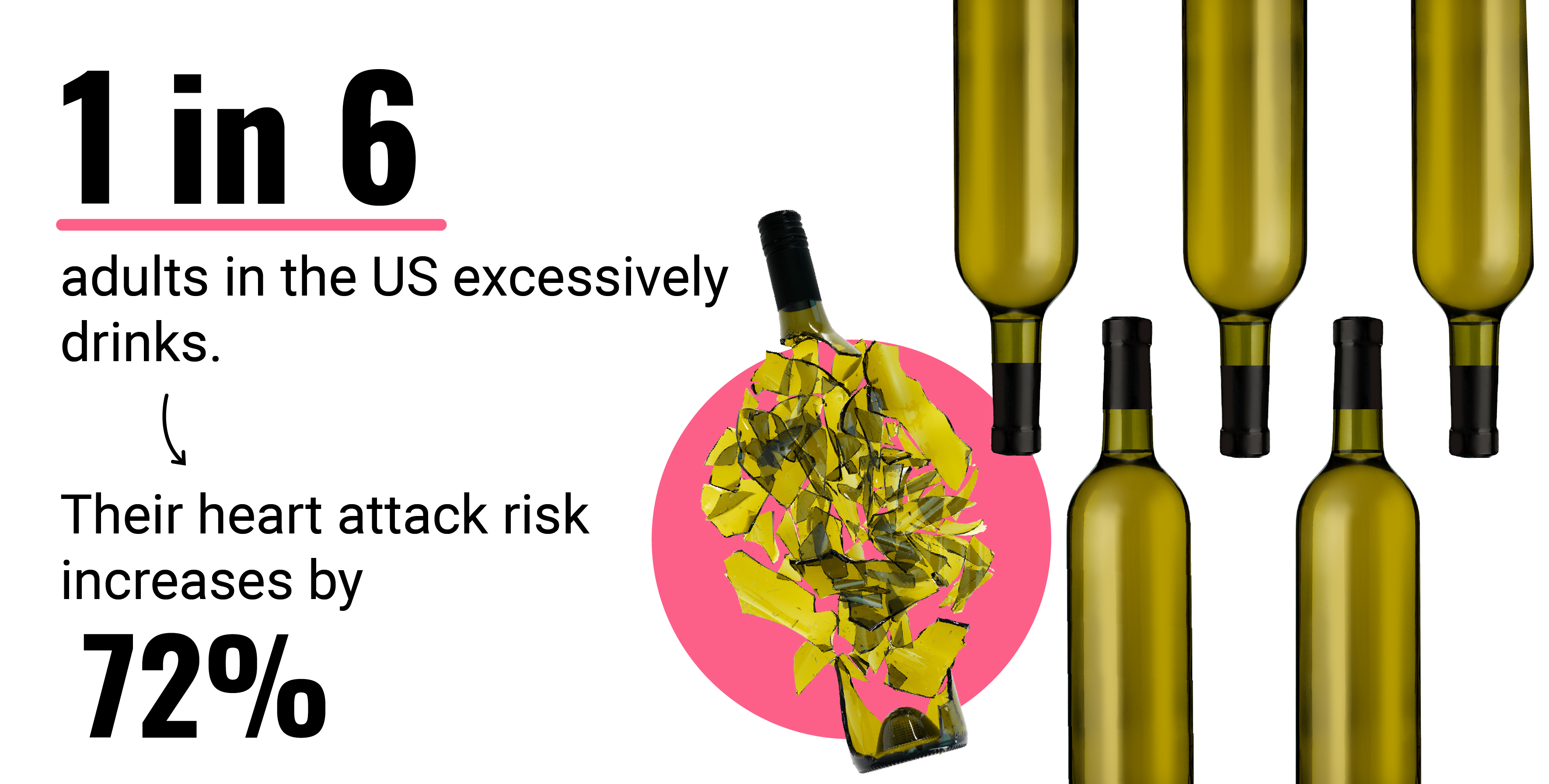
Who are at Risk the Most for Heart Diseases?
Heart disease affects people above 75 years (37.3%), males (12.6%), and American Indians (14.6%) the most [30].
Heart disease statistics show that these groups have the highest risk factors and are most vulnerable to cardiovascular diseases.
Heart Disease by Age
37.3% of older individuals (75+ years) have some form of heart disease. Among younger adults (18 to 44 years), only 4.8% of them suffer from some type of heart disease [30].
Heart Disease by Gender
Heart disease affects 12.6% of men and 10.1% of women [38].
It’s also the leading cause of death among American men and women.
It takes the life of 1 in every 4 men and 1 in every 5 women [28] [29].
Heart Disease by Race
14.6% of American Indians have heart disease. They’re the ethnicity most affected by heart diseases.
Heart diseases affect American Asians the least. Only 7.7% of their population has heart disease [30].
Cultural changes may have something to do with why the disease affects more American Indians. Over the past five decades, changes in the American Indian culture have led to reduced physical activities and a poorer diet. Smoking prevalence among their population has also increased [31].
Heart Disease by Socioeconomic Status
13.5% of the country’s poor population has heart disease. It affects only 10.9% of those who are not poor [30].
13.4% of those who earn less than $35,000 have heart disease. Among those who earn more than $100,000, only 9.8% of them have a heart disease diagnosis [30].
13.9% of unemployed people who worked previously have heart disease. This condition affects employed individuals the least. Only 9.5% of them have heart problems [30].
13.3% of people with some college degree have heart disease. It affects people with a Bachelor’s degree or higher the least. Only 10.9% of them have heart problems [30].
Factors that may have contributed to the disparities in health include:
- Poverty
- Environmental conditions
- Geographic location
- Quality of education and understanding of basic health care
- Access to healthy foods
- Access to quality medical care
- Health insurance
- Stress levels
- Social and personal support systems
- Health beliefs and behaviors
How Common are Heart Attacks?
Heart attacks are very common that, every 40 seconds, one American suffers from it [38].
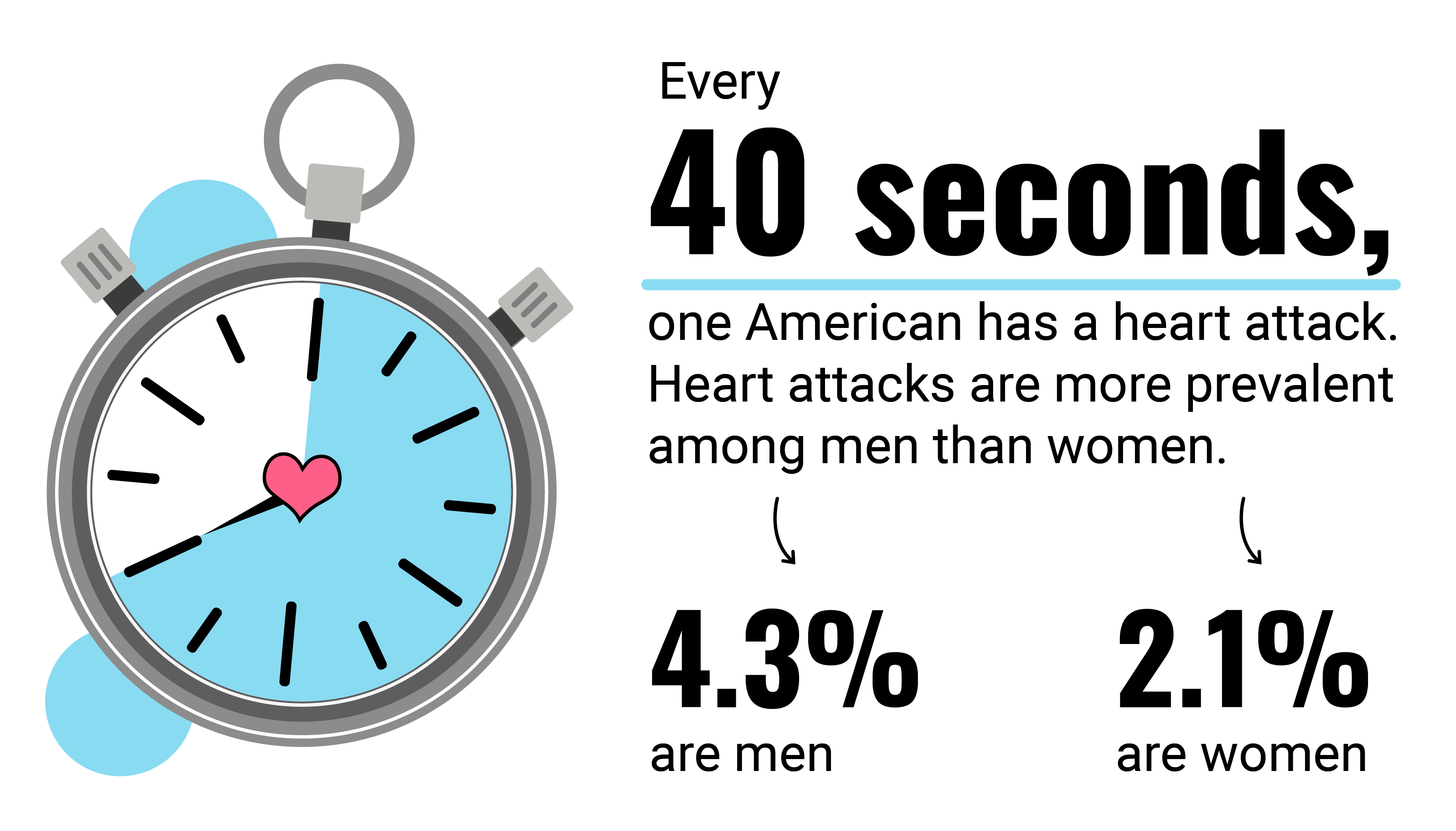
MI is one of the most common diseases of the heart in the US. It happens when the heart suddenly stops receiving an adequate blood supply. Causes include coronary artery spasms or dislodged blood clots blocking the blood flow to the heart. This results in partial or complete occlusion of the artery.
Average Age of Heart Attack
Men tend to suffer from their first heart attack at a younger age, with an average age of 65.6 years. Women, on the other hand, have an average age of heart attack of 72 years [38].
The prevalence of heart attack is higher among men at 4.3% than women at 2.1% [38].
Average Number of Heart Attacks Per Day and Per Year
About 805,000 people suffer from myocardial infarction each year. This translates to 2,205 heart attacks per day [38].
New heart attacks make up the majority at 605,000. 200,000, on the other hand, make up recurrent heart attacks [38].
Of the 805,000, 170,000 make up silent heart attacks. The person may not experience the signs and symptoms like chest pain, but the event has already caused some damage [38].
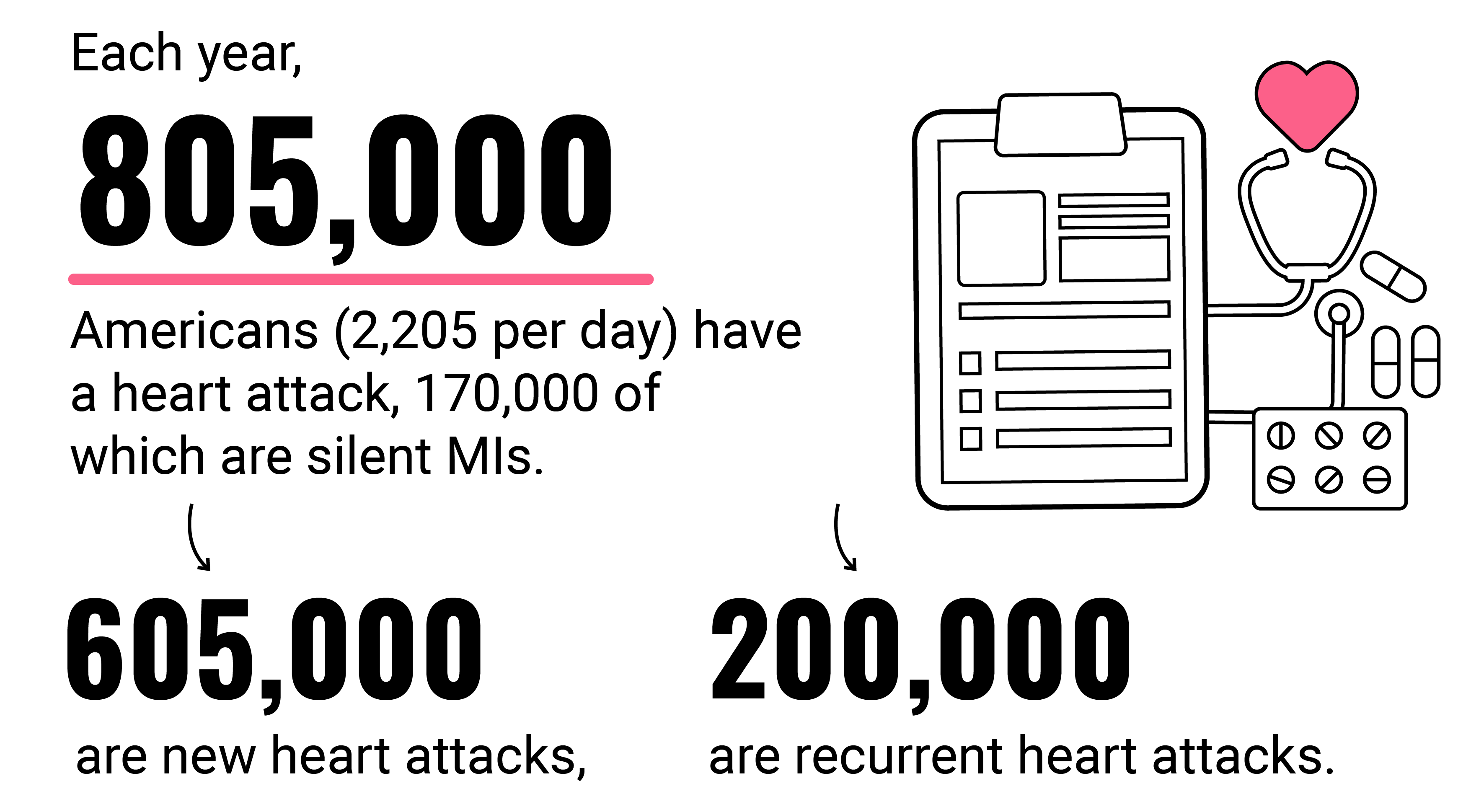
What Percentage of Heart Attacks are Fatal?
About 14% of those who had a myocardial infarction will die from the event [38].
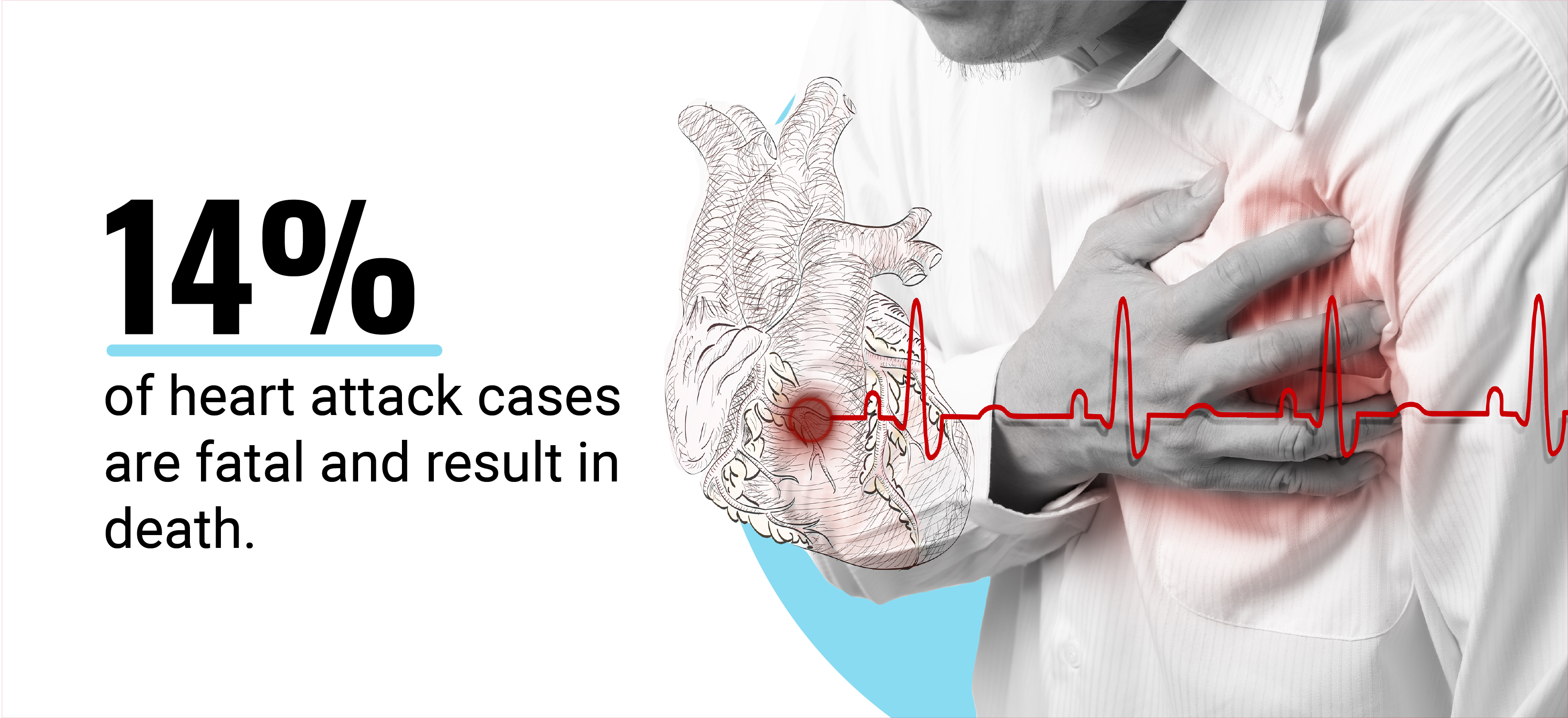
The mortality rate of heart attacks has decreased by about 38%. From 20% in 1995, it decreased by 7.6% points to 12.4% in 2014 [17].
A better understanding of the disease and better disease management reduced the mortality rate. While these saved lives, they also contributed to the increasing number of people with heart failure.
How Many People Have Heart Failure?
6.2 million Americans had heart failure in 2013 to 2016. This has increased from 5.7 million in 2009 to 2012, an increase of 8.77% [40].
If the trend continues, we’d see a 46% increase in the prevalence rate. From 2.4% of the American population in 2012, this can increase to 3% of the population by 2030. This means that, by 2030, more than 8 million people will be suffering from this heart condition [38].
Heart failure, also called congestive heart failure, isn't the same as a heart attack. Heart attacks are a sudden interruption of blood flow to the heart. Heart failure, on the other hand, is a gradual deterioration of heart functions. Causes include any of the risk factors, including MIs. Not only do they damage the heart but also prevent the heart from effectively pumping blood to the rest of the body.
How Many People Die from Heart Failure?
Heart failure accounts for 12.5% of the deaths in 2019. It’s the leading cause of 1 in 8 deaths [38].
The number of people dying from this heart condition per year has also increased. From 54,913 Americans in 1999, it increased to 85,855 in 2020. Based on a 1999 to 2020 report, 58,621 people (median number) die from heart failure each year [9].
Heart Disease Deaths: What is the Death Rate of Heart Disease?
In 2019, coronary heart disease made up 41.3% of all cardiovascular disease deaths in the US. This was followed by stroke at 17.2% and high blood pressure at 11.7% [38].
Coronary heart disease affects about 6.7% or 18.2 million American adults [27]. As such, it also accounts for the highest cause of heart disease death in the US.
Every 36 seconds, one American dies from cardiovascular disease [27].
Coronary artery disease accounts for 1 in every 5 deaths among American adults less than 65 years old [27].
How Many People Die of Heart Disease Each Year?
641,359 people (median number) die from heart disease each year [9]. This means that 1 in every 4 deaths is caused by heart disease [39].
The number of people dying from the disease declined from 725,192 in 1999 to 596,577 in 2011. However, the numbers started picking up again in 2012. From 599,711 in 2012, it rose to 659,041 in 2019 [9].
We’re also seeing a similar trend in major cardiovascular disease-related deaths. From 950,314 in 1999, it dropped to 779,109 in 2011 before increasing again in 2012 to 782,985. By 2019, heart disease-related deaths numbered 869,883 [9].
By 2020, the number of heart disease death rates has increased to 696,962. Major cardiovascular disease-related deaths also increased to 923,237 [9].
According to the National Heart, Lung, and Blood Institute (NHLBI), the COVID-19 pandemic contributed to the increased number of deaths in 2020 [32].
- COVID-19 patients filled the hospitals. This limited medical care to non-COVID-19 patients, including those suffering from acute myocardial infarction and cardiovascular events.
- People missed appointments with their doctors. The delay in getting prompt medical care may have increased heart disease risks.
- Indirect effects of the pandemic like increased stress and financial problems may have also increased health risks.
The Black, Hispanic, and Asian Americans were the most affected ethnicities, compared to White adults. Their risk of dying from a disease of the heart increased by 20% and cerebrovascular disease death risk by 13% between the months of March and August 2020 [32].
Life Expectancy with Heart Disease
The heart muscles don’t regenerate after a cardiac event like an MI. In areas that suffered damage, scar tissues form. They further affect cardiac functions and burden the heart [6].
Life expectancy after a cardiac event declines in people who’ve had heart disease at a younger age.
Men at the age of 50 can expect at least 26.9 more years [11].
- 20.2 years may be heart disease-free and 6.7 years with heart disease, 2.4 years of which may be after a heart attack.
Women at the age of 50, on the other hand, have a longer life expectancy of 31 more years [11].
- 23.1 years of these may be free from the disease, while 7.9 years with heart disease. Of the 7.9 years, 2.1 years may be after a heart attack.
In comparison, men who reached the age of 80 with no heart issues can expect at least 7 more years [11].
- 3.2 years may be heart disease-free and 3.8 years with heart disease, 1.6 years of which may be after a heart attack.
Women who reached 80 years with no heart problems have a longer life expectancy of 9.3 more years [11].
- 4.6 years of these may be free from the condition and 4.7 years with it. Of the 4.7 years, 1.4 years may be after a heart attack.
Women may live longer with and without heart disease than men. However, they don’t live as long as men do after suffering a heart attack.
One reason for this may be that women experience MIs at an older age. Compared to men, they also don’t respond that well to the treatment regimen. Lastly, women tend to ignore the signs and symptoms. This prevents them from seeking immediate help.
These factors may contribute to why 26% of women who experienced myocardial infarctions die within a year after the event, compared to 19% of men. 47% of women compared to 36% of men will either die, develop heart failure, or have a stroke within five years after their first MI [19].
Holiday Heart Syndrome
The months of December through January see a 33% higher number of cardiac deaths than the months of June through September [16].
Colder temperatures may have played a role. It causes vasoconstriction and vasospasm of the blood vessels. These could put unnecessary stress on the heart and increase cardiac workload.
However, other factors also seem to play a role. They contribute to the higher incidence of cardiac deaths during the holiday season.
According to American Addiction Centers’ survey [1]:
- 84% of Americans feel stressed out during the holidays.
- Nearly 50% say they consume the same amount of alcohol. However, 29% also say they consume more alcohol during the holidays.
- 25% say they feel more depressed.
- 62% say they feel more anxious.
All these factors not only increase cardiac workload but also increase the risk of death.
Excessive alcohol consumption, in particular, increases the risk of a phenomenon called holiday heart syndrome [5].
As the name implies, holiday heart syndrome is a type of heart problem induced by overindulging in alcohol and foods, especially those rich in salt, sugar, and fat. Excessive alcohol, coupled with binge eating, cause the heart to beat erratically or irregularly. Called atrial fibrillation, this increases heart attack and stroke risks.
Alcohol consumption has been attributed to 5% to 10% of new-onset atrial fibrillation cases. Another study says excessive alcohol consumption caused as high as 35% of new cases [5].
Holiday heart syndrome is reversible, and symptoms typically disappear after alcohol cessation. It can also be prevented by knowing your limits on alcohol and salty, sugary, and fatty foods.
Cost of Heart Disease in the US
According to the Medical Expenditure Panel Survey (MEPS), heart disease cost $228.7 billion in 2017 to 2018. Of this, $108.8 went to direct costs such as medical care. $119.9 billion went to indirect costs such as lost productivity [38].
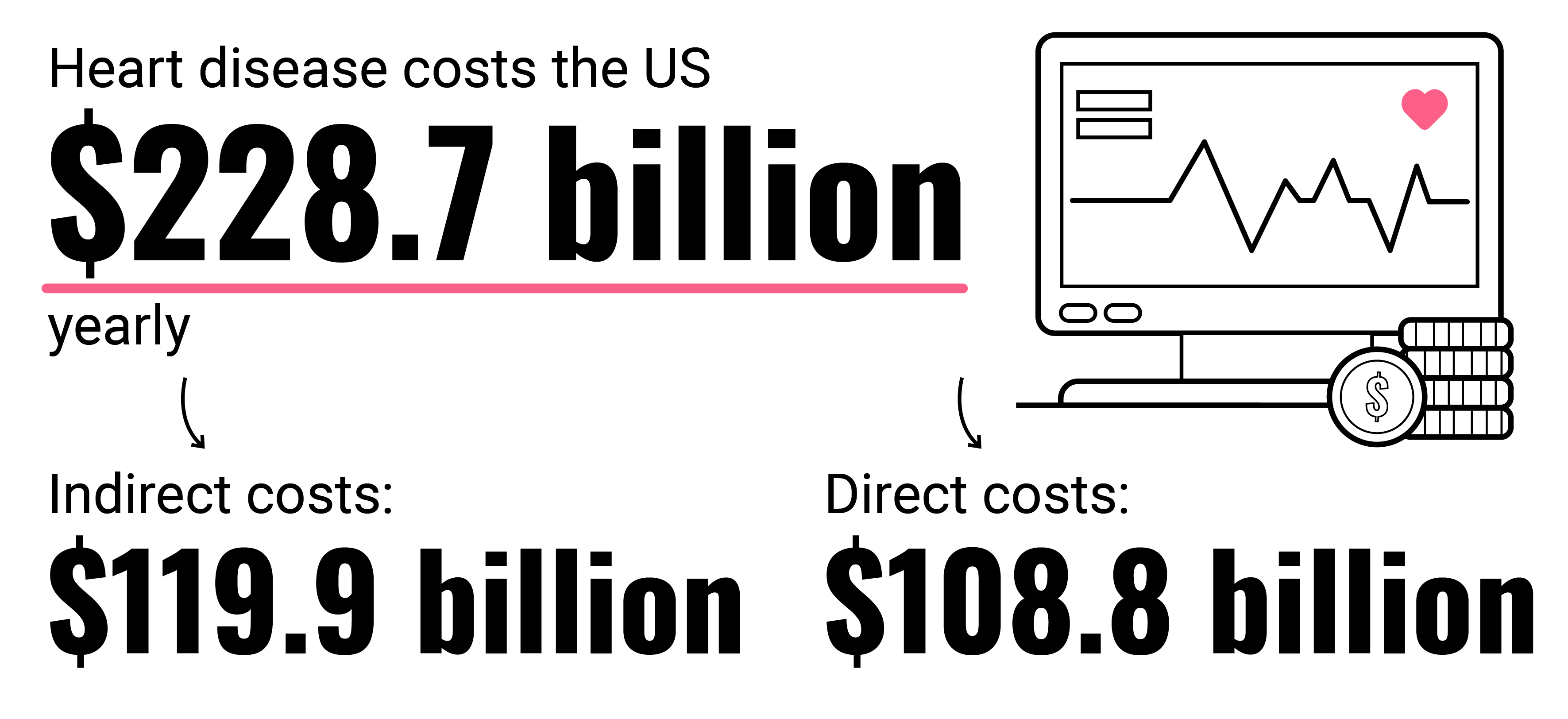
Myocardial infarction cost the most at $12.1 billion. Coronary heart disease came second at $9 billion [38].
Cardiovascular disease, on the other hand, cost more at $378 billion. $226.2 went to direct costs, while $151.8 billion went to indirect costs. Cardiovascular diseases made up 12% of the country’s total health expenditures. It cost more than cancer which was $109 billion [38].
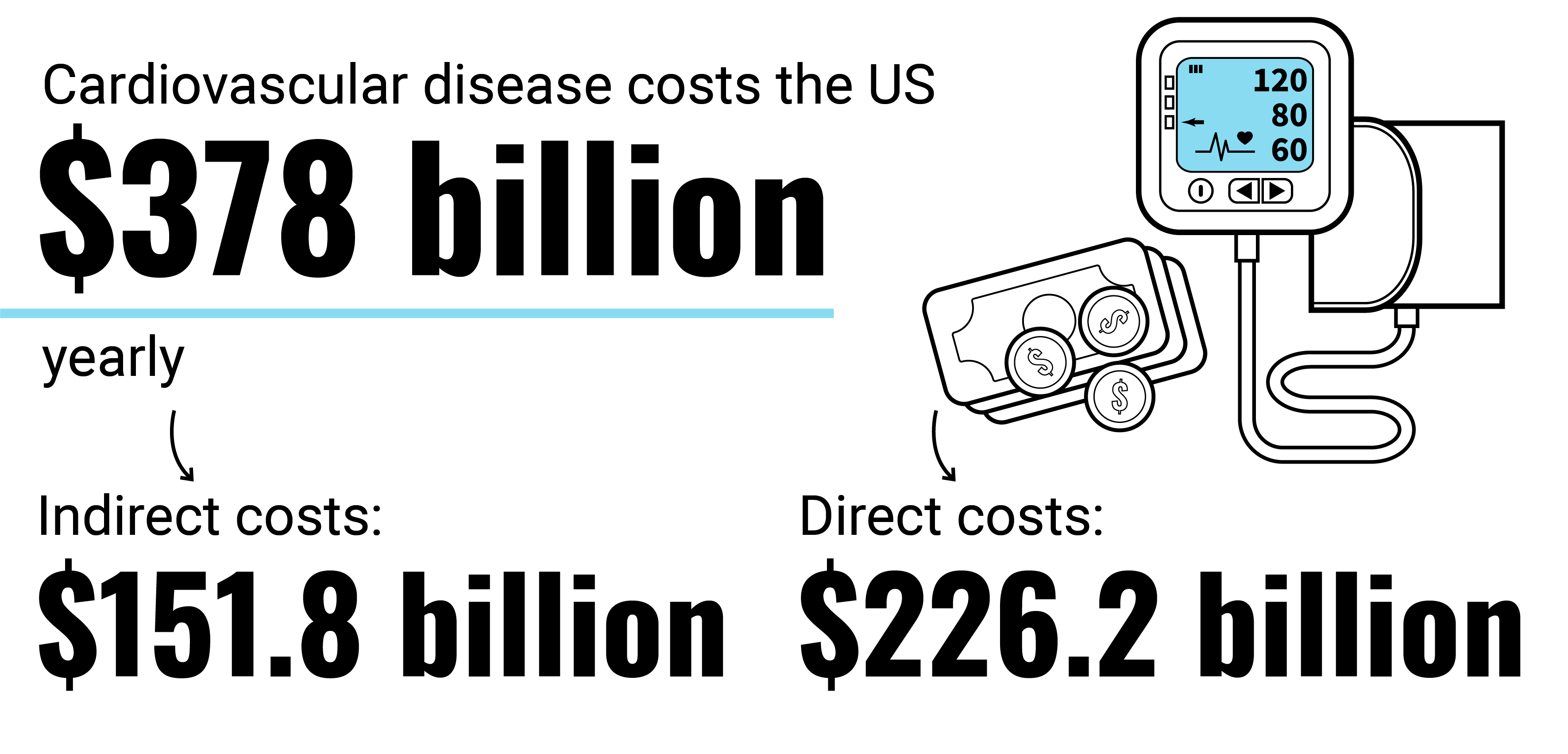
The total cost increased from 2016 to 2017’s report. Between those years, heart disease cost $219.6 billion. Cardiovascular disease also cost $363.4 billion [39].
The future cost of cardiovascular diseases could potentially increase to $1.1 trillion by 2035. The majority will go to direct costs at $748.7 billion. The rest will go to indirect costs at $368 billion. By the same year, cardiovascular diseases will have affected over 45.1% of Americans [3].
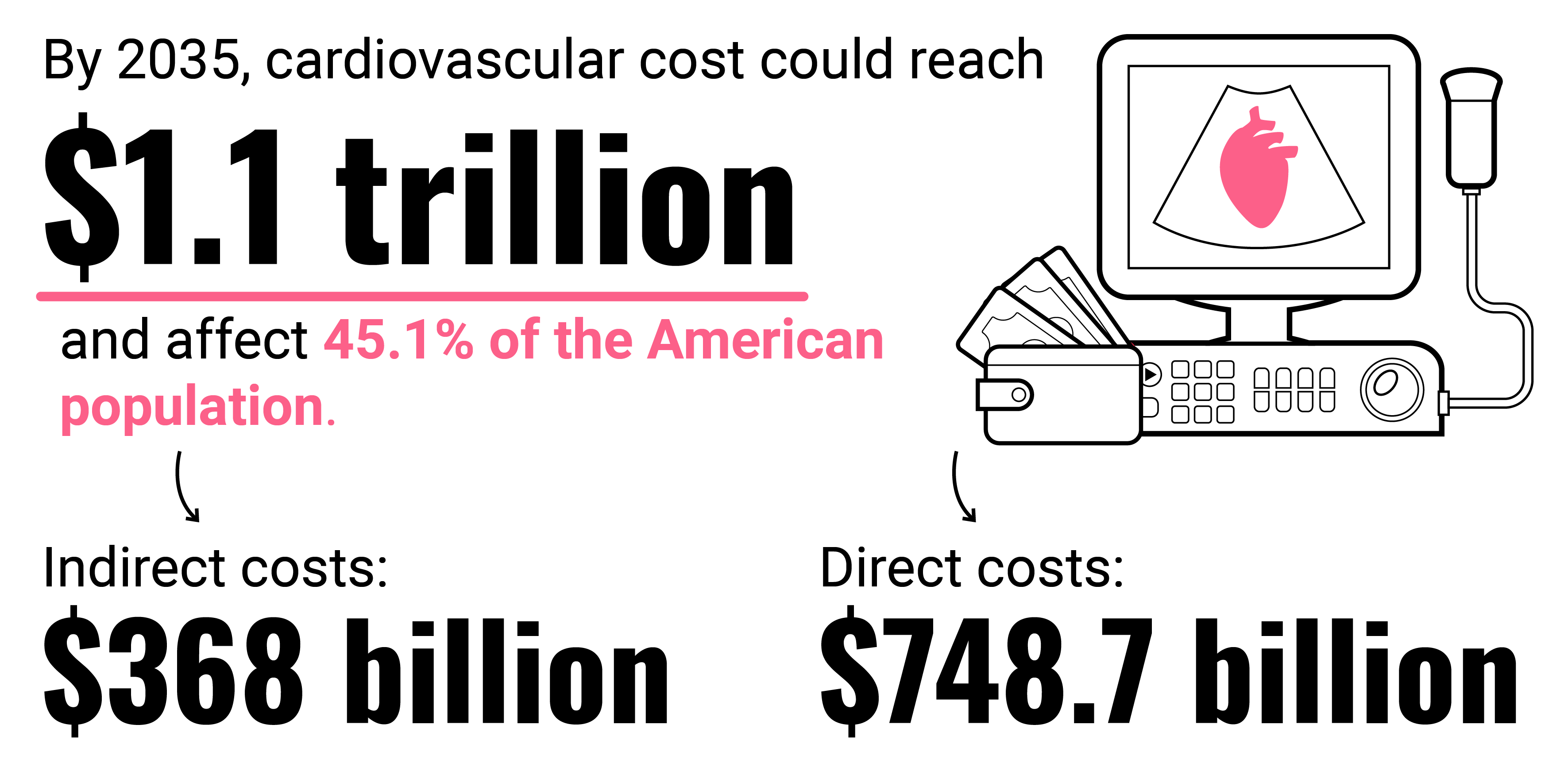
Heart Disease Prevention
Cardiovascular disease and diseases of the heart are costly. To help prevent its development and improve heart health, you need to reduce the risk factors.
- Exercise Daily
Engage in moderate-activity exercises or physical activity for 150 minutes weekly. This can help lower your coronary heart disease risk by 14%. Increasing the duration to 300 minutes weekly can lower risk by 20% [37].
- Stop Smoking
Heavy smokers who quit smoking can reduce their cardiovascular disease risk within five years by as high as 39% [13].
- Consume Less Alcohol
This can help reduce your coronary heart disease risk by 24.7% [20].
- Eat Healthy Foods
A healthy diet reduces the risk of myocardial infarctions by 18% [36].
- Lose Weight
Losing at least 5% to 10% of their body weight results in a 0.5% reduction in HbA1c. HDL cholesterol also decreases by 5 mg/dL and triglycerides by 40 mg/dL. Weight loss also decreases both diastolic and systolic blood pressure by 5 mmHg [41]. Lowering these risk factors decreases your cardiovascular risk.
- Adhere to Your Medication Regimen for Disease Control
Lowering blood pressure by 5 mmHg can reduce stroke risks by 34% and ischemic heart disease risks by 21% [18].
Bringing your HbA1c level under control can decrease cardiovascular events by 44% [10].
Healthy lifestyle choices can help reduce the risk factors of this leading cause of death. It can decrease blood pressure, improve blood glucose levels, and lower high cholesterol levels.
Stroke statistics also show that lifestyle modification can reduce the risk of stroke by up to 50% [33].
Final Thoughts
Cardiovascular disease and diseases of the heart are the most common chronic health problems in the US. It affects 11.2% of American adults and causes 1 in every 4 deaths.
The leading cause of death in the US, heart disease is also one of the most preventable diseases. By having a healthy lifestyle and improving heart health, you can have better disease control.
References
- American Addiction Centers Editorial Staff. (2016). Holiday Highs and Lows. DrugAbuse.com. [1]
- American Heart Association. (2017). Unhealthy diets linked to more than 400,000 cardiovascular deaths. ScienceDaily. [2]
- Benjamin, E. J., Muntner, P., Alonso, A., Bittencourt, M. S., Callaway, C. W., Carson, A. P., Chamberlain, A. M., Chang, A. R., Cheng, S., Das, S. R., Delling, F. N., Djousse, L., Elkind, M. S., Ferguson, J. F., Fornage, M., Jordan, L. C., Khan, S. S., Kissela, B. M., Knutson, K. L., . . . Virani, S. S. (2019). Heart Disease and Stroke Statistics—2019 Update: A Report From the American Heart Association. Circulation, 139(10), 56–528. [3]
- Binge drinking linked with higher heart attack risk. (2015). Harvard T.H. Chan School of Public Health. [4]
- Brown, K. N., Yelamanchili, V. S., & Goel, A. (2022). Holiday Heart Syndrome. Treasure Island (FL): StatPearls Publishing. [5]
- Cardiac Repair and Regeneration. (2020). UCLA Health. [6]
- CDC Maps America’s High Levels of Inactivity. (2020). Centers for Disease Control and Prevention. [7]
- CDC Prevention Programs. (2019). American Heart Association. [8]
- CDC Wonder. (2022). Centers for Disease Control and Prevention. [9]
- Colayco, D. C., Niu, F., McCombs, J. S., & Cheetham, T. C. (2010). A1C and Cardiovascular Outcomes in Type 2 Diabetes. Diabetes Care, 34(1), 77–83. [10]
- Crimmins, E. M., Hayward, M. D., Ueda, H., Saito, Y., & Kim, J. K. (2008). Life With and Without Heart Disease Among Women and Men Over 50. Journal of Women & Aging, 20(1–2), 5–19. [11]
- Division for Heart Disease and Stroke Prevention. (2019). Risks for Heart Disease and Stroke. Million Hearts. [12]
- Duncan, M. S., Freiberg, M. S., Greevy, R. A., Kundu, S., Vasan, R. S., & Tindle, H. A. (2019). Association of Smoking Cessation With Subsequent Risk of Cardiovascular Disease. JAMA, 322(7), 642–650. [13]
- The Facts, Stats, and Impacts of Diabetes. (2022). Centers for Disease Control and Prevention. [14]
- How Smoking Affects Heart Health. (2022). Food and Drug Administration. [15]
- Kloner, R. A., Poole, W. K., & Perritt, R. L. (1999). When Throughout the Year Is Coronary Death Most Likely to Occur? Circulation, 100(15), 1630–1634. [16]
- Krumholz, H. M., Normand, S. L. T., & Wang, Y. (2019). Twenty-Year Trends in Outcomes for Older Adults With Acute Myocardial Infarction in the United States. JAMA Network Open, 2(3), e191938. [17]
- Law, M., Wald, N., & Morris, J. (2003). Lowering blood pressure to prevent myocardial infarction and stroke: a new preventive strategy. National Institutes of Health. [18]
- Mehta, L. S., Beckie, T. M., DeVon, H. A., Grines, C. L., Krumholz, H. M., Johnson, M. N., Lindley, K. J., Vaccarino, V., Wang, T. Y., Watson, K. E., & Wenger, N. K. (2016). Acute Myocardial Infarction in Women. Circulation, 133(9), 916–947. [19]
- Mukamal, K. J., & Rimm, E. B. (2020). Alcohol’s Effects on the Risk for Coronary Heart Disease. National Institutes of Health. [20]
- National Center for Chronic Disease Prevention and Health Promotion. (2006). Cholesterol. Centers for Disease Control and Prevention. [21]
- National Center for Chronic Disease Prevention and Health Promotion. (2022a). About Heart Disease. Centers for Disease Control and Prevention. [22]
- National Center for Chronic Disease Prevention and Health Promotion. (2022b). Adult Obesity Facts. Centers for Disease Control and Prevention. [23]
- National Center for Chronic Disease Prevention and Health Promotion. (2022c). Current Cigarette Smoking Among Adults in the United States. Centers for Disease Control and Prevention. [24]
- National Center for Chronic Disease Prevention and Health Promotion. (2022d). Excessive Alcohol Use. Centers for Disease Control and Prevention. [25]
- National Center for Chronic Disease Prevention and Health Promotion. (2022e). Facts About Hypertension. Centers for Disease Control and Prevention. [26]
- National Center for Chronic Disease Prevention and Health Promotion. (2022f). Heart Disease Facts. Centers for Disease Control and Prevention. [27]
- National Center for Chronic Disease Prevention and Health Promotion. (2022g). Men and Heart Disease. Centers for Disease Control and Prevention. [28]
- National Center for Chronic Disease Prevention and Health Promotion. (2022h). Women and Heart Disease. Centers for Disease Control and Prevention. [29]
- National Center for Health Statistics. (2018). Summary Health Statistics: National Health Interview Survey, 2018. Centers for Disease Control and Prevention. [30]
- National Heart, Lung, and Blood Institute. (2015). Strong Heart Study targets high rate of heart disease among American Indians. National Institutes of Health. [31]
- National Heart, Lung, and Blood Institute. (2021). Cardiovascular disease deaths and disparities increased in 2020. National Institutes of Health. [32]
- Niewada, M., & Michel, P. (2016). Lifestyle modification for stroke prevention: facts and fiction. Current Opinion in Neurology, 29(1), 9–13. [33]
- Rehm, C. D., Peñalvo, J. L., Afshin, A., & Mozaffarian, D. (2016). Dietary Intake Among US Adults, 1999–2012. JAMA, 315(23), 2542–2553. [34]
- Riaz, K. (2020). Hypertensive Heart Disease: Overview, Etiology, Epidemiology. Medscape. [35]
- Sarver Heart Center. (2022). Five Ways to Reduce Heart Attack Risk by 80 Percent. The University of Arizona. [36]
- Sattelmair, J., Pertman, J., Ding, E. L., Kohl III, H. W., Haskell, W., & Lee, I. M. (2011). Dose-Response Between Physical Activity and Risk of Coronary Heart Disease: A Meta-Analysis. Circulation, 124(7), 789–795. [37]
- Tsao, C. W., Aday, A. W., Almarzooq, Z. I., Alonso, A., Beaton, A. Z., Bittencourt, M. S., Boehme, A. K., Buxton, A. E., Carson, A. P., Commodore-Mensah, Y., Elkind, M. S., Evenson, K. R., Eze-Nliam, C., Ferguson, J. F., Generoso, G., Ho, J. E., Kalani, R., Khan, S. S., Kissela, B. M., . . . Martin, S. S. (2022). Heart Disease and Stroke Statistics—2022 Update: A Report From the American Heart Association. Circulation, 145(8), 153–639. [38]
- Virani, S. S., Alonso, A., Aparicio, H. J., Benjamin, E. J., Bittencourt, M. S., Callaway, C. W., Carson, A. P., Chamberlain, A. M., Cheng, S., Delling, F. N., Elkind, M. S., Evenson, K. R., Ferguson, J. F., Gupta, D. K., Khan, S. S., Kissela, B. M., Knutson, K. L., Lee, C. D., Lewis, T. T., . . . Tsao, C. W. (2021). Heart Disease and Stroke Statistics—2021 Update. Circulation, 143(8), 254–743. [39]
- Virani, S. S., Alonso, A., Benjamin, E. J., Bittencourt, M. S., Callaway, C. W., Carson, A. P., Chamberlain, A. M., Chang, A. R., Cheng, S., Delling, F. N., Djousse, L., Elkind, M. S., Ferguson, J. F., Fornage, M., Khan, S. S., Kissela, B. M., Knutson, K. L., Kwan, T. W., Lackland, D. T., . . . Tsao, C. W. (2020). Heart Disease and Stroke Statistics—2020 Update: A Report From the American Heart Association. Circulation, 141(9), 139–596. [40]
- Wing, R. R., Lang, W., Wadden, T. A., Safford, M., Knowler, W. C., Bertoni, A. G., Hill, J. O., Brancati, F. L., Peters, A., & Wagenknecht, L. (2011). Benefits of Modest Weight Loss in Improving Cardiovascular Risk Factors in Overweight and Obese Individuals With Type 2 Diabetes. Diabetes Care, 34(7), 1481–1486. [41]